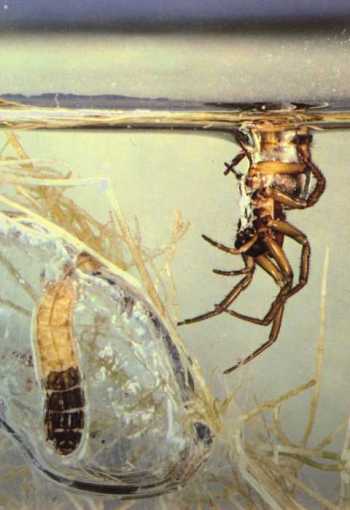

image from http://zdb-imk.physik.uni-karlsruhe.de/~lepper/ws_big.html


image from http://zdb-imk.physik.uni-karlsruhe.de/~lepper/ws_big.html
In relation to our work on buoyancy (another word for the force which
keeps things afloat), I began to do some research on the European Water
spider, Argyroneta aquatica. It turns out that this spider lives
underwater, but it breathes air! Here's how it works: The spider begins
by attaching some webbing to underwater plants. Next, the spider goes to
the surface and dives down with little air bubbles clinging to hairs on
its body. This diving must be hard work, as the air bubbles make the
spider less dense overall (like a life preserver), and the spider must
swim against this buoyant force (force which makes it tend to float). It carries the bubbles to the webbing and shakes them off there; they get caught in the webbing
and form a bigger bubble. Now remember, this bigger bubble would float to
the surface if it wasn't attached, because it is less dense than water --
but the webbing holds it secure. The spider repeats this many times until
the bubble is big enough to live and breathe in: an underwater home. Now
and then the spider has to go to the surface to get more air for its
bubble as it uses up the oxygen; it can also gather oxygen for its chamber
from underwater plants. This spider hunts underwater and brings its prey
back to its bubble to eat.